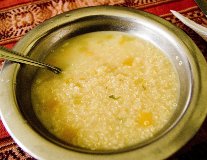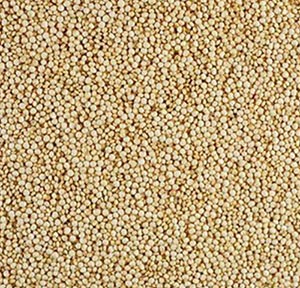Table of Contents
Selection and storage
Dry quinoa seeds, raw and processed can be readily available all around the season in the US stores. Being an unnaturalized crop in the USA, quinoa has to be imported from Bolivia, Peru, and other South American countries. Processed seeds are generally sold in airtight packets and bulk bins.
Look for fine, dry grains roughly the size of pearl millet. They come in different colors, ranging from creamy-white, pink, yellow to
deep brown, depending on cultivar variety.
At home, store the grains in an airtight container in a cool, dry place where they stay fresh for several months. Ground quinoa flour, however, exposes its essential fatty acids to environmental factors which may initiate rapid lipid peroxidation and reduce its lifespan. Therefore, mill it as and when required and store its flour in an air-seal container.
Preparation and serving methods

|
| Sopa de quinua- quinua soup. Photo courtesy: Robert Luna |
The unprocessed quinoa grain has a thick outer coat (hull) that must be removed before fitting for consumption. This outer coating contains
an anti-nutrient compound, Saponin that has a bitter, soapy taste. Virtually, all the available grains of quinoa in the US stores are de-hulled and pre-washed.
At home, wash in cold water repeatedly until all of its foam disappears before cooking. Quinoa cooked in the same way as you cook other staples like buckwheat, rice, etc. Roughly, one cup of dry grains cooks to three cups. Cooked quinoa becomes fluffy, chewy and attains pearl like translucency and pleasant taste.
Here are some serving tips:
-
Mixing quinoa floor with other cereal flours such as maize, wheat, oat, etc., enriches overall protein quality of the meal, compensating for the limiting amino-acid level of grains.
-
Traditionally, native Andeans used quinoa seeds to prepare porridge, soup and milled into flour to make bread, porridge (lawa), buns, polenta, and non-alcoholic cold drinks (quinua chicha).
-
In the rest of the world, its grains used in many ways like any other cereal grains to make pilaf, porridge, flakes, puddings, etc.
-
Its flour may be used in numerous methods to make bread, bun, cake, pasta, noodles, cookie, biscuits, etc.
-
Young, tender quinoa leaves (chiwa) and flower heads are also eaten like leafy vegetables and indeed, make good salads,
stews, and soups mixed with amaranth, spinach, and beet leaves. -
Cold-pressed quinoa oil has been one of the sought after oil used as dressing as well as cooking oil in place of rice bran or corn oils.
Safety profile
Unpolished (unwashed) quinoa seed carries in its outer cover saponin, a triterpenoid compound. Saponin has a bitter
soap-like taste, which, when consumed, might result in stomach pain, flatulence, and laxative diarrhea. Naturally, this covering over the
grains protects them from insects and birds.
Quinoa leaves and flower-heads compose oxalic acid and should be blanched in boiling water before being eaten. (Medical disclaimer).
≺≺ Back to Nuts and seeds from Quinoa. Visit here for an impressive list of nuts and seeds with complete illustrations of their nutrition facts and health benefits.
≺≺ Back to Home page.
Further Resources:





More Stories
The One Thing You Should Never, Ever Do if You Have Insulin Resistance and Want to Lose Weight
Tuna Salad Lunch Box – JSHealth
Advanced Wellness Course – Heart Health